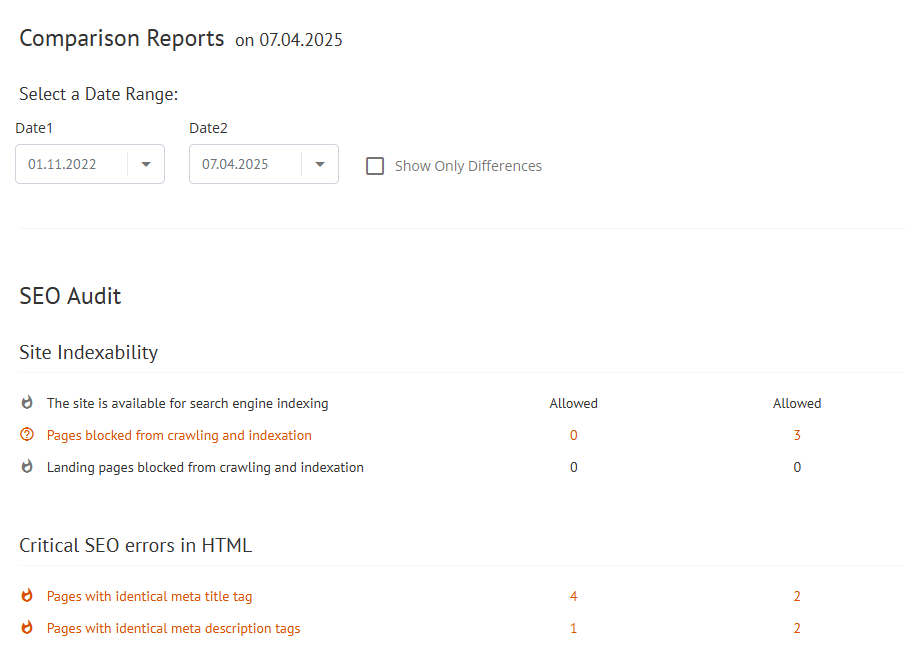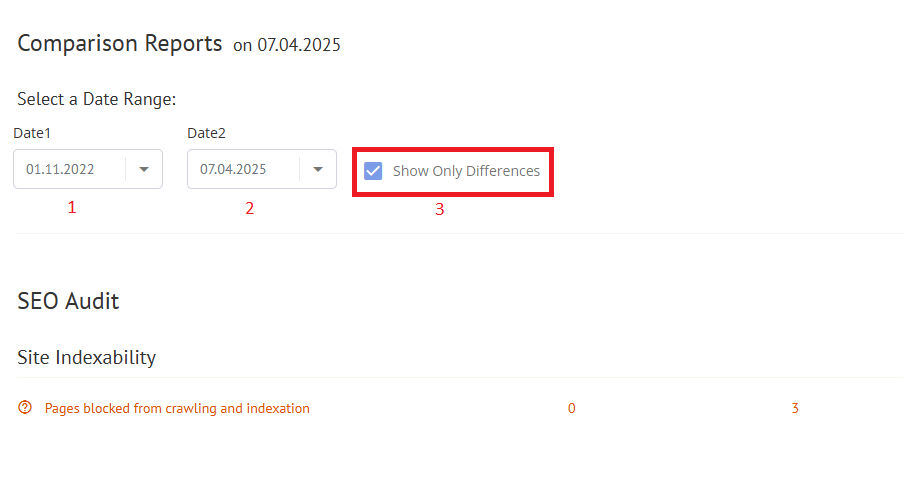Comparison Reports
In the world of digital marketing, understanding the performance of your website is crucial for ongoing success. The "Comparison Reports" section within Labrika serves as a powerful tool that allows users to monitor changes in resources during the optimization process. This feature is particularly valuable for businesses and individuals looking to enhance their SEO strategies and improve their website's visibility in search engine results.

What Are Comparison Reports?
Comparison reports are analytical tools that allow users to assess the performance of their website over different time periods. By comparing specific metrics, users can identify trends, strengths, and weaknesses in their SEO strategy. This can ultimately lead to more informed decision-making and improved website performance. In Labrika, these reports provide a comprehensive overview of how various elements of your website have changed over time, allowing for a detailed analysis of optimization efforts.
Tracking Resource Dynamics
Within the "Comparison Reports" section, users have the ability to analyze and compare summary reports across selected time periods. This functionality allows for a detailed examination of the key characteristics that influence a website's position in search results. By utilizing these reports, businesses can gain insights into their SEO strategies, allowing them to make informed decisions based on data.
Setting Up Your Comparison Reports
To begin using the comparison report tools, you must specify the dates for the reports you wish to compare. In the fields labeled "Date 1" and "Date 2," simply enter the dates corresponding to the reports you want to analyze. This process enables users to track changes over time and assess the impact of their optimization efforts. By selecting specific dates, you can focus on particular campaigns or changes that were implemented, making it easier to evaluate their success.

Displaying Changes Effectively
One of the standout features of Labrika's comparison reports is the option to display only the differences between the two selected dates. By ticking the "Differences only" checkbox, users can streamline their analysis, focusing solely on the parameters that have changed. This targeted approach helps in identifying significant shifts in performance metrics, making it easier to understand the effectiveness of implemented strategies.
The Importance of Regular Audits
To fully leverage the capabilities of the "Comparison Reports" section, conducting regular audits of your website is essential. This practice ensures that the service can accurately account for any changes that have occurred. It is generally recommended to perform a comprehensive audit at least twice a month. Regular audits not only keep your data up-to-date but also allow for a continuous evaluation of your SEO efforts. By maintaining a consistent auditing schedule, you can ensure that you are always aware of how your website is performing and what adjustments may be necessary.
Benefits of Using Comparison Reports
Utilizing comparison reports in Labrika offers numerous advantages for website optimization. Here are some key benefits:
- Enhanced Visibility: By analyzing performance comparison reports, businesses can identify trends that affect their visibility in search results. This can help you understand which strategies are working and which ones need to be adjusted.
- Actionable Insights: The detailed comparison reports provide actionable insights that can inform future marketing strategies. Instead of making decisions based on assumptions, you can rely on data-driven insights to guide your actions.
- Competitive Edge: Understanding your competitors through competitor comparison reports can help identify strengths and weaknesses, allowing for strategic adjustments. By analyzing what your competitors are doing, you can find opportunities to differentiate yourself in the market.
- Performance Tracking: Regularly tracking changes ensures that you remain aware of your website's performance over time, enabling timely interventions. This proactive approach can help you stay ahead of potential issues before they become significant problems.
Understanding Key Performance Metrics
When analyzing your website's performance through comparison reports, it’s essential to focus on key performance metrics. Here are some critical metrics to consider:
- Organic Traffic: This metric indicates the number of visitors arriving at your site through organic search results. It highlights the effectiveness of your SEO strategies and helps gauge the success of your content. Monitoring organic traffic can also reveal trends over time, allowing you to see the impact of your optimization efforts.
- Keyword Rankings: Monitoring your keyword rankings helps you understand how well your content is performing in search results. This information can guide adjustments to your content and SEO strategies. By tracking your keywords, you can identify opportunities for new content or optimization of existing pages.
- Backlink Profile: A strong backlink profile is crucial for SEO success. Analyzing changes in backlinks can provide insights into your site's authority and trustworthiness, as well as the effectiveness of your outreach efforts. Understanding your backlink profile helps you identify potential link-building opportunities and areas for improvement.
- Page Load Speed: Website performance is significantly impacted by loading speed. Regularly checking this metric can help you identify areas for improvement, as faster-loading pages tend to have lower bounce rates and higher engagement. Tools like Google PageSpeed Insights can provide recommendations for optimizing load times.
Utilizing Detailed Comparison Reports
Detailed comparison reports allow you to dive deep into your website's performance over time. These reports can highlight specific areas that require attention, such as:
- Content Performance: Analyze how different pieces of content are performing and which ones drive the most traffic. This information can guide future content creation efforts and help you focus on topics that resonate with your audience. Understanding which content performs best can also inform your promotional strategies.
- User Engagement: Metrics like bounce rate and average session duration can reveal how engaging your content is to visitors. High engagement rates often correlate with better conversion rates, making this an essential area to monitor. Improving user engagement can lead to higher customer satisfaction and loyalty.
- Conversion Rates: Ultimately, understanding how well your site converts visitors into customers is crucial for measuring success. By tracking conversion rates, you can identify which pages or elements of your site are most effective at driving sales or sign-ups. Testing different calls to action (CTAs) and page layouts can help optimize conversion rates further.
Best Practices for Using Comparison Reports
To maximize the benefits of comparison reports, consider these best practices:
- Regular Monitoring: Set a schedule for reviewing your comparison reports to stay on top of performance changes. Consistent monitoring allows you to quickly identify trends and make necessary adjustments. Regular reviews can help you catch issues early and capitalize on new opportunities.
- Document Findings: Keep a record of your findings to track progress over time. Documenting insights and changes can help you create a historical reference that informs future strategies. This practice can also help you communicate findings to your team and stakeholders more effectively.
- Collaborate with Your Team: Share insights from your comparison reports with your team to foster a collaborative approach to SEO strategy. Engaging your team in discussions about performance can lead to innovative ideas and improvements. Regular team meetings to discuss findings can enhance collective knowledge and creativity.
- Adapt Strategies: Use the insights gained from comparison reports to adapt your SEO strategies and improve overall performance. Being flexible and willing to pivot based on data will help you stay competitive in the ever-evolving digital landscape. Always be prepared to test new approaches and refine your tactics based on the latest data.
Future Trends in SEO
As the digital landscape continues to evolve, so do the strategies and tools for effective SEO. Here are some future trends to keep an eye on:
- Voice Search Optimization: With the rise of smart speakers and voice-activated devices, optimizing for voice search is becoming increasingly important. This involves focusing on natural language processing and long-tail keywords that reflect how people speak. Adapting your content to answer common questions can improve your visibility in voice search results.
- Mobile-First Indexing: Google’s shift to mobile-first indexing means that your website should be optimized for mobile devices. Ensuring a responsive design and fast loading times on mobile is crucial for maintaining search rankings. A mobile-friendly site enhances user experience and can significantly impact your SEO performance.
- AI and Machine Learning: The use of AI in SEO is growing, with algorithms becoming more sophisticated. Understanding how AI impacts search rankings can help you adjust your strategies accordingly. Tools that utilize AI can provide deeper insights and predictive analytics, allowing for more informed decision-making.
- User Experience (UX) Signals: Google is increasingly prioritizing user experience signals, such as page speed, mobile usability, and interactivity. Focusing on creating a seamless user experience can boost your SEO performance. Enhancing UX can lead to higher engagement rates and improved conversion rates.
- Content Quality and E-A-T: Expertise, Authoritativeness, and Trustworthiness (E-A-T) are becoming critical factors in content ranking. Producing high-quality, well-researched content that showcases your expertise will be essential for SEO success. Establishing E-A-T can help build credibility and trust with your audience.
Final Thoughts
Staying ahead in the SEO game requires continuous learning and adaptation. By leveraging tools like Labrika and integrating best practices, you can create a robust SEO strategy that drives traffic and conversions. Remember, the digital landscape is dynamic, and keeping your strategies up-to-date will ensure long-term success. Embrace the power of comparison reports to gain insights, track progress, and make informed decisions that propel your website toward greater visibility and success.
Conclusion
In conclusion, the "Comparison Reports" section in Labrika is an invaluable resource for anyone looking to enhance their website's SEO performance. By regularly utilizing these reports, businesses can track changes, identify trends, and make informed decisions based on actionable insights. The integration of online comparison tools, alongside a commitment to regular audits, ensures that you remain competitive in an ever-changing digital environment. By understanding your performance metrics and adapting your strategies accordingly, you can not only improve your website's visibility but also achieve your business goals more effectively.
